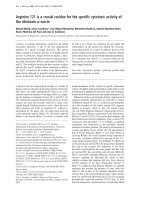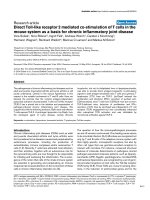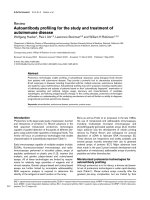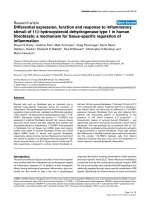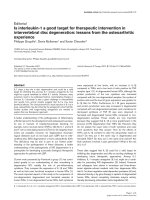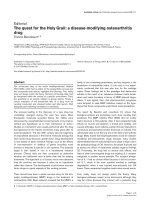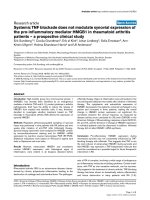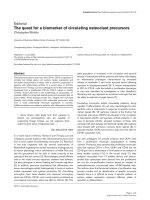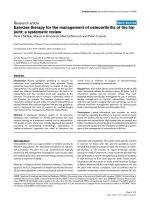Báo cáo y học: " Study protocol for a group randomized controlled trial of a classroom-based intervention aimed at preventing early risk factors for drug abuse: integrating effectiveness and implementation research" ppt
Bạn đang xem bản rút gọn của tài liệu. Xem và tải ngay bản đầy đủ của tài liệu tại đây (336.99 KB, 11 trang )
BioMed Central
Page 1 of 11
(page number not for citation purposes)
Implementation Science
Open Access
Study protocol
Study protocol for a group randomized controlled trial of a
classroom-based intervention aimed at preventing early risk factors
for drug abuse: integrating effectiveness and implementation
research
Jeanne Poduska*
1
, Sheppard Kellam
1
, C Hendricks Brown
2
, Carla Ford
1
,
Amy Windham
1
, Natalie Keegan
3
and Wei Wang
4
Address:
1
American Institutes for Research, Baltimore, MD, USA,
2
Department of Epidemiology and Public Health, University of Miami, Miller
School of Medicine, Miami, Florida, USA,
3
Innovations Institute, Division of Child and Adolescent Psychiatry, University of Maryland, Baltimore,
MD, USA and
4
Department of Epidemiology and Biostatistics, College of Public Health, University of South Florida, Tampa, FL, USA
Email: Jeanne Poduska* - ; Sheppard Kellam - ; C Hendricks Brown - ;
Carla Ford - ; Amy Windham - ; Natalie Keegan - ;
Wei Wang -
* Corresponding author
Abstract
Background: While a number of preventive interventions delivered within schools have shown
both short-term and long-term impact in epidemiologically based randomized field trials, programs
are not often sustained with high-quality implementation over time. This study was designed to
support two purposes. The first purpose was to test the effectiveness of a universal classroom-
based intervention, the Whole Day First Grade Program (WD), aimed at two early antecedents to
drug abuse and other problem behaviors, namely, aggressive, disruptive behavior and poor
academic achievement. The second purpose the focus of this paper was to examine the utility of
a multilevel structure to support high levels of implementation during the effectiveness trial, to
sustain WD practices across additional years, and to train additional teachers in WD practices.
Methods: The WD intervention integrated three components, each previously tested separately:
classroom behavior management; instruction, specifically reading; and family-classroom
partnerships around behavior and learning. Teachers and students in 12 schools were randomly
assigned to receive either the WD intervention or the standard first-grade program of the school
system (SC). Three consecutive cohorts of first graders were randomized within schools to WD
or SC classrooms and followed through the end of third grade to test the effectiveness of the WD
intervention. Teacher practices were assessed over three years to examine the utility of the
multilevel structure to support sustainability and scaling-up.
Discussion: The design employed in this trial appears to have considerable utility to provide data
on WD effectiveness and to inform the field with regard to structures required to move evidence-
based programs into practice.
Trial Registration: Clinical Trials Registration Number: NCT00257088
Published: 2 September 2009
Implementation Science 2009, 4:56 doi:10.1186/1748-5908-4-56
Received: 12 March 2009
Accepted: 2 September 2009
This article is available from: />© 2009 Poduska et al; licensee BioMed Central Ltd.
This is an Open Access article distributed under the terms of the Creative Commons Attribution License ( />),
which permits unrestricted use, distribution, and reproduction in any medium, provided the original work is properly cited.
Implementation Science 2009, 4:56 />Page 2 of 11
(page number not for citation purposes)
Background
The educational sector, as a normative setting for children,
is an important delivery system for drug abuse prevention.
A number of preventive interventions directed at aggres-
sive, disruptive behavior and other antecedent risk factors
such as poor achievement have shown both short-term
and long-term impact in epidemiologically-based rand-
omized field trials. However, prevention programs are
often not implemented with high quality in schools [1-3].
Until recently, the primary concern of prevention
researchers has been to test the impact of interventions
through efficacy and effectiveness trials. The result is that
many interventions have been tested without precise spec-
ification of the model of support necessary to implement
and sustain intervention practices with high quality over
time.
In fall 2003, we began the third randomized field trial car-
ried out by the senior members of this research team in
collaboration with the Baltimore City Public School Sys-
tem. This trial focused on testing interventions aimed at
aggressive, disruptive behavior and poor achievement,
separately and in combination. Results of the first two tri-
als [4-15] provided support for undertaking this trial in
which we combined three intervention components
classroom-behavior management; academic instruction,
particularly in reading; and family-classroom partner-
ships into one integrated intervention called the Whole
Day First Grade Program (WD). This trial was designed to
bring together effectiveness and implementation research.
The design supported an effectiveness trial of the WD
compared with the standard school district program (SC).
The design also supported an examination of the utility of
a multilevel structure to support high levels of implemen-
tation during the effectiveness trial, to sustain WD prac-
tices across additional years, and to train additional
teachers in WD practices. This paper presents the imple-
mentation portion of the protocol in which we followed
teachers with subsequent cohorts of children to study sus-
tainability and scaling-up. Also see Additional File 1:
'Description of WD intervention, student sample, and
measures of student outcomes' and Additional File 2: 'WD
cohort two student sample figure'.
Specific aims and hypotheses
The specific aim and hypotheses regarding implementa-
tion (aim three) follow logically from the aims of the
effectiveness trial (aims one and two).
Aim one
Model the malleability of developmental paths by evalu-
ating the effectiveness of the WD program, directed at
reducing the antecedent risk factors for later substance
abuse, comorbid mental and behavioral disorders, and
school failure. We hypothesize that students in WD class-
rooms will exhibit less aggressive, disruptive behavior,
more on-task behavior, and gains in student achievement,
particularly in reading, compared with their counterparts
in SC classrooms over the course of first grade and to the
end of third grade.
Aim two
Measure the variation in the impact of WD by examining
moderating factors at the level of the child and the social
contexts of family, classroom and school, peers, and com-
munity. In line with the results from our previous trials,
we hypothesize that: the impact of WD will be stronger
among children who begin first grade with lower readi-
ness and poorer student behavior than their classmates;
and the impact of WD will vary as a function of the quality
of teacher practices, with improved teacher practices lead-
ing to student improvements in behavior and achieve-
ment, proximally and through third grade.
Aim three
Examine the utility of the support structure: during the
effectiveness trial; as teachers implement WD in consecu-
tive cohorts of first graders (sustainability); and as WD
practices are taught by school system employees to teach-
ers new to WD (scaling-up). We hypothesize that: the
multilevel support structure will result in sustained high
levels of WD practices with three consecutive cohorts of
first graders; and the multilevel support structure will
result in high levels of WD practices with additional teach-
ers when they are trained in WD practices.
Methods
Overview of the design
The within-school design involved 12 public elementary
schools and two first-grade classrooms within each
school. Within each school, three consecutive cohorts of
children were randomly assigned to first-grade classrooms
as they enrolled. Classrooms/teachers were randomized
to intervention condition in the first year, with one
teacher assigned to WD and one teacher assigned to SC.
Because every school had a WD and a SC classroom,
schools served as blocking factors, and comparison of
intervention effects could be obtained for each school.
This two-level randomized block design allowed us to
hold school, family, and community catchment area fac-
tors fixed while examining intervention effects at the class-
room level, and examine main effects and test
hypothesized variations in impact on the basis of varia-
bles such as gender, students' individual aggressive behav-
ior, teacher self-efficacy, and classroom levels of aggressive
behavior. Random assignment of children to classrooms
allowed two classrooms within a school to be comparable
at baseline and was extremely efficient in testing the main
effect of a classroom intervention [5,6,16,17].
Implementation Science 2009, 4:56 />Page 3 of 11
(page number not for citation purposes)
Aware of the possibility of intervention leakage with this
classroom-based, within-school design, we implemented
procedures that had successfully limited such leakage in
the prior trials, such as meeting with principals monthly
[16]. In addition, the SC teachers received training and
support in WD as part of the design in the third year of the
trial. We found no evidence of contamination in the
schools with internal controls in either of the first two tri-
als [5,16] or in this trial.
Procedures for random assignment
We drew upon our prior experience as well as knowledge
in the field to develop protocols for the random assign-
ment of both students and teachers. Here, we describe the
procedures for random assignment in this multilevel trial.
For details regarding the effectiveness arm of the trial in
which we followed students over first grade and into third
grade, see Additional File 1: 'Description of WD interven-
tion, student sample, and measures of student outcomes'
and Additional File 2: 'WD cohort two student sample fig-
ure'.
Schools
We began with a pool of 66 elementary schools in two
adminstrative areas of the school district. Schools were
excluded if all the students attending the school received
special education or other special services; the school was
operated by an entity other than the school system; the
first-grade curriculum was not the standard district curric-
ulum; or the school had fewer than two or more than five
first-grade classrooms. We excluded large schools because
they were less common and tended to have different
organizational structures than smaller schools. Twenty-six
of the 66 schools were excluded as a result of these criteria.
Because academic achievement was a primary target of the
WD intervention, we decided that the schools performing
less well academically would be eligible to be part of the
WD initiative. The 40 schools remaining after the first
exclusion step were ranked by third-grade academic
achievement on the standardized achievement test used
by the school system, third grade being the lowest grade at
which a standardized achievement test was used to rate
student achievement. In October 2002, principals of the
20 lowest performing schools participated in a lottery
draw to randomly assign schools to participate either as
one of eight schools deemed development schools, where
we piloted intervention components and conducted staff
training on assessment procedures, or as one of 12
schools deemed trial schools, where the randomized field
trial would take place (see Figure 1). The trial was con-
ducted in these 12 schools for three consecutive school
years beginning in 2003 to 2004.
Classrooms/teachers
In April 2003, all 37 first-grade classrooms/teachers in the
12 schools participating in the randomized field trial were
randomly assigned to condition. In each school, one
teacher was randomly assigned to be a WD classroom/
teacher, one was randomly assigned to be a wait-listed SC
classroom/teacher, and all other first-grade teachers were
randomly assigned to be nonparticipating classrooms/
teachers. Teachers in both WD and SC classrooms were
followed as they taught three consecutive cohorts of first
graders. In a type of wait-listed control, SC teachers who
served as controls for cohorts one and two were trained in
the third year to deliver WD to cohort three first-grade stu-
dents. The effectiveness trial relied on efficient within-
school comparisons of WD and SC for cohort one and
cohort two students from first to third grade. The sustain-
ability question centered on whether WD teachers' prac-
tices remained high or fell off across the three cohorts. The
scale-up question centered on whether the practices of the
former SC teachers improved as well as the consequent
child outcomes when they were trained to deliver WD.
While each of the 12 schools maintained the design by
having one WD classroom and one SC classroom each
year for three years, there were changes at the teacher level
as teachers left the school. We anticipated that some
teachers would change over the years, and we established
a protocol for such changes. We stipulated that if a teacher
left, the classroom would not change condition and the
new teacher would be assigned the departing teacher's
intervention status. If the replacement was a teacher
already in the school, our protocol stipulated that this
teacher could not have previously been assigned to a con-
dition (WD or SC) within the trial. The patterns of teacher
mobility are shown in Figure 1. There were no changes in
either WD or SC teachers in schools one to five; the same
teachers taught the WD and SC classrooms for all three
years of the trial. Schools six to 12 experienced some
degree of teacher mobility.
Overall, the changes were typical of staffing in large urban
school districts and a reality when conducting research in
real-world settings. For example, in schools seven and
eight, the original SC teacher stopped teaching during the
first year of the study and a long-term substitute taught for
the remainder of the year. In the second year of the study,
these classrooms were assigned a permanent teacher who
taught first grade in both the second and third years of the
study. Of note is the fact that in the second year, school six
had two SC classrooms. After the initial assignment of stu-
dents to classrooms, the school decided to add a third
first-grade classroom because enrollment was greater than
anticipated. Because we did not have an established pro-
tocol for the situation, we worked with the school to
determine appropriate actions to maintain the random
Implementation Science 2009, 4:56 />Page 4 of 11
(page number not for citation purposes)
design. We randomly selected 10 students to come out of
the original WD and SC classrooms before the interven-
tion began, creating a new control classroom. The teacher
of this newly formed classroom did not have experience
teaching first grade and was not trained in the school sys-
tem's first-grade curriculum, so the original SC class and
the new control classroom were combined in a team-
teaching model. By the end of the year, these two classes
had separated back into two traditional, discrete classes.
We decided to collect data in all three classrooms at each
time point throughout the year. As a result, we have one
WD classroom and two SC classrooms for school six in the
second year of the trial. In the third year, school six had
only two first-grade classrooms and they were taught by
the initially assigned WD and SC teachers. In spite of this
unexpected design modification, we were able to main-
tain random assignment of children.
Although there were no instances of protocols being bro-
ken no teachers changed their design it is important to
note that SC teachers were replaced at twice the rate over
the three years of the study (n = 8) compared with WD
teachers (n = 4). We have hypothesized that as teachers
gain mastery in their classroom with regard to their prac-
tices in classroom behavior management and instruc-
tional content, they will be less likely to leave a school or
the teaching profession. In keeping with this hypothesis,
we would expect to see a lower rate of attrition in WD
classrooms than in SC classrooms. As we move to an anal-
ysis of the data, we will test for systematic bias at the level
of the classroom and at the school/community level.
Structure to support sustainability and scale-up
In developing the support structure required for teachers
to learn, implement, and sustain WD practices and for
additional teachers to be trained, we focused on three
areas: understanding the multilevel organizational struc-
ture of the school system; delivering professional develop-
ment to teachers; and systematically monitoring teacher
practices and support to teachers.
Multilevel structure of the school system
To understand the level and nature of the mandate,
authority, accountability, and resources necessary to sus-
tain and scale-up WD practices, we needed to understand
the multilevel organizational structure of the school sys-
tem. Figure 2 presents the organizational structure at the
time of the WD trial. The Board of School Commissioners
(the school board) had the legal authority to oversee all
operations of the school district. The chief executive
WD Teachers Over Three YearsFigure 1
WD Teachers Over Three Years. R = random assignment; WD = Whole Day First Grade Program classroom; SC =
standard classroom (control); SY = school year.
Elementary schools in two
administrative areas assessed for
eligibility n=66
Random assignment of 20
eligible elementary schools
Schools excluded n=46
Step 1: n=26 special ed school; curriculum not
standard; operator other than school system
Step 2: n=20 3
rd
grade reading scores above
median on CTBS (2001-02)
Development
Schools
n=8
Trial Schools
n=12
August 2002
Determined
eligibility of
schools
October 2002
Randomization
of eligible schools
Cohort 1
SY 2003/04
Cohort 2
SY 2004/05
Cohort 3
SY 2005/06
April 2003:
Initial random
assignment of
classrooms
(teachers)
1
1
1
WD
SC
1
1
1
#1
1
1
1
WD
SC
1
1
1
#2
1
1
1
WD
SC
1
1
1
#3
1
2
3
WD
SC
1
1
1
#10
1
1
1
WD
SC
1
2
3
#9
1
1
1
WD
SC
1
3
3
2
#8
1
1
1
WD
SC
1
1
1
#5
1
1
1
WD
SC
1
1
1
#4
1
1
2
WD
SC
1
2
2
#11
1
2
2
WD
SC
1
1
1
2
#12
1
1
1
WD
SC
1
1
1
2
#6
1
1
1
WD
SC
1
3
3
2
#7
R
R
R
RR
R
RRRR
R
R
Implementation Science 2009, 4:56 />Page 5 of 11
(page number not for citation purposes)
officer (CEO) of the school district (the superintendent)
oversaw all aspects of school district administration. The
chief academic officer (CAO) served under the CEO and
was responsible for all K through 12 instruction, academic
as well as behavior and social emotional learning. Under
the direction of the CAO, the city schools were divided
into four elementary areas, a middle school area, and a
high school area, each overseen by an area academic
officer (AAO). AAOs were responsible for providing sup-
port to principals as well as to the schools more generally.
Each area office had at least one coach who worked
directly with schools to provide professional develop-
ment. Within the school building, teachers were sup-
ported by the principal, school-based instructional
coaches, and support staff such as social workers and psy-
chologists.
We worked with the school system to create two teams to
support the effectiveness trial and the goal of sustaining
and scaling-up practices in the school system the Core
Team and the Schools Committee. The Core Team com-
prised individuals who held key positions of authority in
the school system, along with senior members of the
American Institutes for Research (AIR team). District
members included the CAO, senior staff from the offices
of curriculum and instruction and professional develop-
ment, and the area superintendents whose schools were
participating in the trial. The Core Team was responsible
for the implementation and continued monitoring of the
randomized field trial within the school district, and met
monthly to review progress against benchmarks and to
anticipate and resolve problems. The Core Team's role
was also to address the challenges that often impede the
uptake of interventions into general practice, including
the time to deliver the intervention, the ease of implemen-
tation, the compatibility of the intervention with the mis-
sion and vision of the institution, and the cost of the
intervention [1-3,18-29].
Principals of the 12 participating schools, along with Core
Team members and senior AIR staff, participated on the
Schools Committee. The committee met monthly to
address issues pertinent to the field trial, such as maintain-
ing fidelity, developing procedures for randomization of
teachers/classrooms and students, engaging with parents
and garnering consent, determining ways to introduce the
field trial to the school community, maintaining the
morale of standard classroom (comparison) teachers, and
making decisions at the school level regarding oversight,
monitoring, and allocation of resources.
Multilevel Structure of a School SystemFigure 2
Multilevel Structure of a School System.
STRUCTURE OF THE SCHOOL SYSTEM
1
Board of School Commissioners
1
Chief Executive Office
r
1: Central Office
1
Professional
Development
1
Curriculum &
Instruction
2
Area Academic
Office
r
2
Lead Coach
Coach
3
Principal
3
Teache
r
= Authorit
y
= Function
2: Academic Area Offices
1
Chief Academic Office
r
3
3: School Building
Implementation Science 2009, 4:56 />Page 6 of 11
(page number not for citation purposes)
Professional development to teachers
As part of the WD trial, we addressed the primary concern
of school system leaders with regard to professional devel-
opment for teachers, namely, that the role of the WD facil-
itator be specified with precision so that practices would
be observable and replicable. Because we were interested
in building capacity within the school system, we decided
that AIR staff would not train teachers directly but would
train school district employees to be WD facilitators who
would work directly with teachers. This model was decid-
edly in contrast to the prior two field trials in which
research staff worked directly with classroom teachers.
In developing the model of coaching and support to
teachers, we were informed by the emerging literature on
professional development for educators and on adult
learning. This work highlights the importance of provid-
ing opportunities for active learning through observation,
meaningful discussion, practice, and reflection [30-32].
Research also suggests that professional development is
best conceptualized as an ongoing process rather than a
single event, and that professional development activities
should be aligned with one's professional work [30,33-
35] and incorporated into one's daily professional work
[30,36-38].
Literature on adult learning and school reform empha-
sizes the importance of collective participation of teachers
within schools, grouped by grade level, or of principals
across schools [39-42]. A concept that became critical to
our coaching model and our work with the Schools Com-
mittee and the Core Team is that supporting change at the
organizational level requires linkages across levels in the
system, not just within levels in the system [43,44]. Stated
another way, while professional community matters at
specific levels such as schools [45], it is critical to create
communities of learners within and across the various lev-
els of the organization [46,47]. As defined by Resnick and
Glennan, nested learning communities are 'organizations
in which all individuals and units are expected to upgrade
their capacities continuously in accord with a shared set of
instructional principles and strategies. In this design,
instructional leadership, coupled with reciprocal account-
ability between 'layers' of the organization, provide pro-
fessional learning opportunities specifically geared to the
district's vision of instruction' [46].
The support provided to the teacher was primarily techni-
cal in that the WD facilitator was considered the expert in
WD implementation practices and served as a mentor to
the teacher. WD facilitators had expertise in the theory
and practice of WD and classroom behavior management
more broadly as well as the interpretation and use of data
regarding teacher practices and student behavior. WD
facilitators spent one day per week in the classroom with
each teacher and supported teachers in bringing together
the new knowledge of WD learned in the pre-implemen-
tation training with their craft knowledge of classroom
teaching [48]. The WD facilitators spent most of their time
working directly with teachers in classrooms, observing,
planning, modeling and mentoring, and providing feed-
back [48,49].
Observations of teacher practices in the classroom pro-
vided the foundation of the WD facilitators' work. The
facilitators used the WD implementation checklist each
month throughout the entire school year to determine the
type, amount, and focus of professional development.
The checklist provided information regarding the occur-
rence and quality of teacher practices on both general
practices and specific core elements of each component of
WD. Using these data, the WD facilitators prioritized
coaching needs and worked with the teacher to create a
professional development plan that specified goals, target
areas for mentoring, and coaching strategies and activities
to be undertaken. WD facilitators supported teachers in
WD practices through modeling of practices, guided prac-
tice, visits to other classrooms to observe WD implemen-
tation, conferences, and joint planning. The ability to
work through trust with the teacher was a critical skill for
facilitators; not all teachers welcomed a facilitator into
their classroom or were open to the support the facilitator
offered [50,51].
The extant literature provided little guidance about the
pace and focus of coaching over the course of a year. We
decided on a predetermined amount of coaching support,
with WD facilitators spending additional time with teach-
ers who needed more support. Each facilitator supported
four schools, devoting one day per week supporting the
WD teacher in each school. WD facilitators were trained
during the first year of the trial by intervention team mem-
bers who were part of the research staff.
Systematic monitoring of intervention practices and
support
In recent years, researchers have recognized that the deliv-
ery of intervention practices is usually variable and that
this variability affects outcomes [1,16,52-59]. To under-
stand the occurrence and quality of WD practices and the
support delivered directly to teachers, we measured teach-
ers' practices with regard to WD implementation as dis-
cussed above; facilitators' practices in supporting teachers;
and the availability of resources such as materials, plan-
ning time, and release time for professional development,
particularly those provided by the principal.
Measures and data collection
Classroom observations of student behavior and teacher
practices were conducted three times in first grade: base-
Implementation Science 2009, 4:56 />Page 7 of 11
(page number not for citation purposes)
line/autumn, mid-year/January, and spring/May. Each
observation took four hours over two days, and did not
disrupt the classroom activities. Teacher interviews about
student behavior were conducted with first-grade teachers
at the same three time points. When each cohort reached
third grade, its current teacher was interviewed. In fall and
spring of first grade and spring of third grade, students
were assessed individually in a quiet area of the school on
reading and reading-related skills; students were also
asked about experiencing symptoms of depression and
anxiety; see Additional File 1: 'Description of WD inter-
vention, student sample, and measures of student out-
comes'. School records were collected at the end of each
school year.
Measures of teachers' practices
We conducted classroom observations using a variation of
teacher observation/student engagement [60]. In this
time-sampling schema, a teacher's instructional practice
and students' behavior are recorded minute by minute.
For a teacher's instructional practice, observers code the
instructional format and content of teaching. Eight
instruction categories range from whole class to small
groups to students working on their own, and include a
category for non-reading instruction. Twenty content
codes cover four domains: reading comprehension, word
work, oral language and writing, and non-reading-related
activities. The content codes were extended to include
feedback in response to behavior (corrective, praise, puni-
tive, directive). Inter-rater reliabilities of >0.80 are main-
tained. At the end of each timed observation, observers
use the checklist of teacher's practices to rate the instruc-
tional and behavior management strategies exhibited dur-
ing the session. The form parallels the WD
implementation checklist and provides an independent
measure of program implementation in WD classrooms,
as well as information on classroom behavior manage-
ment and instructional strategies in SC classrooms. Items
were added to the teacher interview to assess the strategies
that teachers used to engage with families and the level of
caregiver response to the strategies.
Measures of fidelity
The WD implementation checklist provided information
about teacher practices along two dimensions, practices
that were general to the classroom and practices that were
intervention-specific. Thirty-six behavioral indicators pre-
cisely defining the core elements of the three intervention
components were rated on whether defined practices
occurred (yes/no) and with what quality (scale of one to
six). A global rating was also given for each of the three
intervention components. Measures of family-classroom
partnership included attendance sheets for activities to
which parents were invited, such as classroom orienta-
tion, class meetings, and the family read-alouds. The use
of the home-link telephone line, a messaging system for
teachers and parents, was monitored. Checklists were
developed to rate the degree to which principals and facil-
itators fulfilled their clearly defined roles related to sup-
porting the teacher and the implementation of the WD
program.
Statistical analyses and power
The analyses for Aim three, sustainability and scaling-up
of WD practices, proceed logically from the analyses sup-
porting the effectiveness trial of WD.
Analyses for Aim one: Malleability of developmental paths
We are carrying out formal growth analyses to evaluate
how WD affects the course of reading skills and achieve-
ment, aggressive behavior, and depressive symptoms.
Intervention effects will be modeled as both mean differ-
ences in latent growth trajectories for the slope and differ-
ences in the covariance between intercept and slope by
intervention group, a type of intervention by baseline
interaction [61]. These analyses will include school- and
classroom-level clustering. Following this series of multi-
level analyses for single repeated measures, we will con-
duct multilevel growth analyses for first-grade through
third-grade outcomes [62] to test for both main effects
and interactions involving the intervention with baseline
characteristics.
Analyses for Aim two: Variation in impact
We will also examine whether the intervention affects
children differently by using baseline measures of reading
skills and aggressive behavior, as well as parent involve-
ment. We have found that additive models [11,15],
because they include nonparametric models with smooth
changes in impact as a function of baseline, are excellent
tools to distinguish the degree of benefit that different
children receive from this particular intervention. A sec-
ond method for examining variation in impact is examin-
ing how baseline interacts with intervention condition to
affect growth trajectories [61,63-65]. These intervention-
by-baseline models extend the univariate models into the
growth curve framework, and allow changes in slope to be
affected simultaneously by both intervention and base-
line. Thus we will examine whether the best growth trajec-
tory improvement from the intervention occurs more for
higher- or lower-risk children.
A further set of analyses will be based on growth mixture
modeling (GMM) [15,64,66] using Mplus software [62].
GMM allows fitting multiple growth trajectories, for
example, early and late starters for aggression, and testing
whether the intervention affects these groups differently.
We can also carry out growth mixture analyses with a cat-
egorical distal outcome as well as time-to-event, or sur-
vival, measures (such as time of first suspension). In these
Implementation Science 2009, 4:56 />Page 8 of 11
(page number not for citation purposes)
general growth mixture models (GGMM) [15,64], param-
eters of individual growth trajectories, including inter-
cepts, slopes, and higher-order shape parameters, may be
influenced by baseline characteristics, intervention status,
and time-dependent covariates. GGMM also allows indi-
viduals to follow a class of growth trajectories. An impor-
tant part of this model is that class membership is an
unobserved category variable. Nevertheless, like latent
class analyses, GGMM permits both predictors and
responses to be related to the unobserved class member-
ship. Model selection for GGMM will be based on both
the bootstrap likelihood ratio test and the Bayesian Infor-
mation Criterion [67] with examination of model fit
[64,68,69].
Analyses for Aim three: Sustainability and scaling-up of
WD practices
We will examine the extent to which the impact of WD on
children's learning and behavior is explained by the level
of by the teacher implementation, as well as school-level
support, over time. We have successfully examined such
implementation measures in the past [16] when we deter-
mined that poor implementation of the intervention fully
explained the lack of improvement in some schools. Sus-
tainability will be tested by comparing the practices and
subsequent child outcomes for the WD teachers over two
as well as three years with those of their SC counterparts
for the first two years. Scaling-up will be tested by compar-
ing the practices and child developmental outcomes for
the original SC teachers in their last year with those in pre-
vious years and with those of WD teachers. The difference
in SC measures across cohorts assesses this extendibility,
and the power is expected to be similar to that for testing
the intervention in cohort one because here each teacher
serves as his or her own control.
Statistical power
In cohort one, we expect to have power of 0.79 to test the
WD main effect on end-of-first-grade reading when the
true effect size is 0.25, compared against total variation in
the sample. This calculation is based on specification of
multivariate means, variances, and covariances from data
from prior trials conducted in Baltimore. The prior studies
provide estimates of each source of variation as well (chil-
dren, classrooms within schools, and schools) [70]. It
assumes that individual variation is twice as large as
school variation, that classroom variation at the time of
randomization was negligible, and that the variation in
intervention impact by school is a third of the overall var-
iation, with effect size. Because this earlier trial involved a
smaller number of schools (nine instead of 12 schools)
and a less comprehensive intervention compared with
that in the present trial, we anticipate having higher statis-
tical power than in the previous trial. In that trial, we were
able to report significant main effects and interactions
[10,16]. The power is nearly identical for third-grade main
effect analyses as it is for end-of-first-grade analyses, even
when we allow for 20% attrition, primarily from mobility.
This loss in power through attrition is generally more than
offset by the increase in power from growth curve analysis
[61].
For testing whether the intervention improved teacher
practices, statistical power is slightly higher, for the same
size effect, compared with analyses of child outcomes.
This difference occurs because the teacher measures are
not subject to the added statistical error arising from child
variation. Thus, we expect to have sufficient power to
detect moderate size effects in this trial on teacher prac-
tices across cohorts. Our hypotheses state that the WD
effects on the original WD teachers should increase from
cohort one to cohorts two and three. We plan to test this
with a two-level linear trend model across cohorts. A test
for nonlinear trend (one DF) can also be carried out. The
trend tests are expected to have higher power than our
original tests of sustainability because there should be
stronger improvements of these teachers over the cohorts.
Discussion
The WD trial was deliberately designed to bring together
research on program effectiveness with research on pro-
gram implementation. Although the model of support to
teachers was not experimentally manipulated, we are
learning a great deal about the multilevel structure that
needs to be in place to ensure that teachers can learn,
implement, and sustain evidence-based intervention prac-
tices with high quality over time and that support prac-
tices being scaled-up. This information will inform the
next generation of interventions focused on enhancing
program implementation.
Ethical review
Ethical approval for this trial was obtained by the Institu-
tional Review Board at the American Institutes for
Research on July 17, 2002.
Competing interests
The authors declare that they have no competing interests.
Authors' contributions
JP, SK, and CHB conceived the study and collaborated
throughout. JP served as project director of the trial and
drafted this manuscript. CHB prepared all randomiza-
tions. CF served as the intervention chief for the study. She
oversaw the development and refinement of the interven-
tion components and was responsible for the training and
supervision of the WD facilitators. NK worked with CF to
develop the classroom-family partnership component
and served as a community liaison. AW led the collection
of assessments and the data management and served as an
Implementation Science 2009, 4:56 />Page 9 of 11
(page number not for citation purposes)
analyst for the study. WW provided analytic models for
mediation and moderation. All authors have read and
approved the final manuscript.
Additional material
Acknowledgements
We thank our partners the students, parents, teachers, and administrators
of the Baltimore City Public School System (BCPSS) who have contributed
to this body of research for over 20 years. We are grateful to the preven-
tion science methodology group, who offered thoughtful feedback on the
design and analytic strategies employed in this study. We thank colleagues
who contributed to the development of the study and the interventions,
including John Reid, Patricia Chamberlain, Becky Fetrow, Nicholas Ialongo,
and Kimberly Kendziora. We are grateful for the careful editing and
thoughtful suggestions of Sarah Crowne.
The WD trial has been funded by the NIDA through R01DA15409 and
R01DA19984. Additional support for the design of the trial is funded by
NIMH and NIDA through R01MH040859. Initial planning for the WD trial
took place under a NICHD grant to develop preventive interventions
aimed at reducing violence (R21HD40051).
References
1. Dusenbury L, Brannigan R, Falco M, Hansen WB: A review of
research on fidelity of implementation: implications for drug
abuse prevention in school settings. Health Educ Res 2003,
18:237-256.
2. Elliott DS, Mihalic S: Issues in disseminating and replicating
effective prevention programs. Prev Sci 2004, 5:47-53.
3. Ringwalt CL, Ennett S, Johnson R, Rohrbach LA, Simons-Rudolph A,
Vincus A, Thorne J: Factors associated with fidelity to sub-
stance use prevention curriculum guides in the nation's mid-
dle schools. Health Education and Behavior 2003, 30:375-391.
4. Brown CH: Statistical methods for preventive trials in mental
health. Statistics in Medicine 1993, 12:289-300.
5. Dolan LJ, Kellam SG, Brown CH, Werthamer-Larsson L, Rebok GW,
Mayer LS, Laudolf J, Turkkan JS, Ford C, Wheeler L: The short-term
impact of two classroom-based preventive interventions on
aggressive and shy behaviors and poor achievement. Journal
of Applied Developmental Psychology 1993, 14:345.
6. Kellam SG, Rebok GW, Ialongo N, Mayer LS: The course and mal-
leability of aggressive behavior from early first grade into
middle school: results of a developmental epidemiologically-
based preventive trial. J Child Psychol Psychiatry 1994, 35:259-281.
7. Kellam SG, Rebok GW, Mayer LS, Ialongo N, Kalodner CR: Depres-
sive symptoms over first grade and their response to a devel-
opmental epidemiologically based preventive trial aimed at
improving achievement. Development and Psychopathology 1994,
6:463-481.
8. Kellam SG, Anthony JC: Targeting early antecedents to prevent
tobacco smoking: findings from an epidemiologically based
randomized field trial. Am J Public Health 1998, 88:1490-1495.
9. Kellam SG, Ling X, Merisca R, Brown CH, Ialongo N: The effect of
the level of aggression in the first grade classroom on the
course and malleability of aggressive behavior into middle
school. Dev Psychopathol 1998, 10:165-185.
10. Ialongo NS, Poduska JM, Werthamer L, Kellam S: The distal impact
of two first-grade preventive interventions on conduct prob-
lems and disorder in early adolescence. Journal of Emotional and
Behavioral Disorders 2001, 9:146-160.
11. Kellam SG, Brown CH, Poduska JM, Ialongo NS, Wang W, Toyinbo P,
Petras H, Ford C, Windham A, Wilcox HC: Effects of a universal
classroom behavior management program in first and sec-
ond grades on young adult behavioral, psychiatric, and social
outcomes. Drug Alcohol Depend 2008, 95(Suppl 1):S5-S28.
12. Poduska JM, Kellam SG, Wang W, Brown CH, Ialongo NS, Toyinbo P:
Impact of the Good Behavior Game, a universal classroom-
based behavior intervention, on young adult service use for
problems with emotions, behavior, or drugs or alcohol. Drug
Alcohol Depend 2008, 95(Suppl 1):S29-S44.
13. Petras H, Kellam SG, Brown CH, Muthen BO, Ialongo NS, Poduska
JM: Developmental epidemiological courses leading to anti-
social personality disorder and violent and criminal behav-
ior: effects by young adulthood of a universal preventive
intervention in first- and second-grade classrooms. Drug Alco-
hol Depend 2008, 95(Suppl 1):S45-S59.
14. Wilcox HC, Kellam SG, Brown CH, Poduska JM, Ialongo NS, Wang
W, Anthony JC: The impact of two universal randomized first-
and second-grade classroom interventions on young adult
suicide ideation and attempts. Drug Alcohol Depend 2008,
95(Suppl 1):S60-S73.
15. Brown CH, Wang W, Kellam SG, Muthen BO, Petras H, Toyinbo P,
Poduska J, Ialongo N, Wyman PA, Chamberlain P, Sloboda Z, MacKin-
non DP, Windham A, Prevention Science and Methodology Group:
Methods for testing theory and evaluating impact in rand-
omized field trials: intent-to-treat analyses for integrating
the perspectives of person, place, and time. Drug Alcohol
Depend 2008, 95(Suppl 1):S74-S104.
16. Ialongo NS, Werthamer L, Kellam SG, Brown CH, Wang S, Lin Y:
Proximal impact of two first-grade preventive interventions
on the early risk behaviors for later substance abuse, depres-
sion, and antisocial behavior. Am J Community Psychol 1999,
27:599-641.
17. Brown CH, Liao J: Principles for designing randomized preven-
tive trials in mental health: an emerging developmental epi-
demiology paradigm. Am J Community Psychol 1999, 27:673-710.
18. Adelman HS, Taylor L: On sustainability of project innovations
as systemic change. Journal of Educational and Psychological Consul-
tation 2003, 14:1-25.
19. Coburn CE: Rethinking scale: Moving beyond numbers to
deep and lasting change. Educational Researcher 2003, 32:3-12.
20. Datnow A, Castellano M: Teachers' responses to Success for
All: how beliefs, experiences, and adaptations shape imple-
mentation. American Educational Research 2000, 37:775-799.
21. Elias MJ, Zins JE, Graczyk PA, Weissberg RP: Implementation, sus-
tainability, and scaling up of social-emotional and academic
innovations in public schools. School Psychology Review 2003,
32:303-319.
22. Fagan AA, Mihalic S: Strategies for enhancing the adoption of
school-based prevention programs: lessons learned from the
Blueprints for Violence Prevention replications of The Life
Skills Training Program. Journal of Community Psychology 2003,
31:235-253.
23. Gottfredson Associates Inc: National Study of Delinquency in Schools
(Final Report, Grant No. 96-MU-MU-008), Ellicott City, MD 2000.
Additional file 1
Description of WD intervention, student sample, and measures of stu-
dent outcomes. Description of WD intervention, student sample, and
measures of student outcomes.
Click here for file
[ />5908-4-56-S1.doc]
Additional file 2
WD cohort 2 student sample. This figure shows the random assignment
and design status of a cohort of students from initial random assignment
prior to the start of first grade to the end of the first grade year. WD =
students randomized to Whole Day First Grade Program; SC = students
randomized to standard classroom (control); Other = students rand-
omized to first grade classrooms not participating in the trial; circles
denote students who left a study condition and were reassigned to another
study condition (denoted by a triangle).
Click here for file
[ />5908-4-56-S2.pdf]
Implementation Science 2009, 4:56 />Page 10 of 11
(page number not for citation purposes)
24. Gottfredson DC: Schools and Delinquency New York: Cambridge Uni-
versity Press; 2001.
25. Gottfredson DC: School-based crime prevention. In Preventing
Crime: What Works, What Doesn't, What's Promising: A Report to the
United States Congress Washington, DC: U.S. Department of Justice,
Office of Justice Programs; 1997.
26. Payne AA, Gottfredson DC, Gottfredson GD: School predictors of
the intensity of implementation of school-based prevention
programs: results from a national study. Prev Sci 2006,
7:225-237.
27. Hallfors D, Godette D: Will the 'principles of effectiveness'
improve prevention practice? early findings from a diffusion
study. Health Educ Res 2002, 17:461-470.
28. McLaughlin MW: The Rand change agent study revisited:
macro perspectives and micro realities. Educational Researcher
1990, 19:11-16 [ />11].
29. Mihalic S, Ballard D, Michalski A, Tororice J, Cunningham L, Argamaso
S: Blueprints for Violence Prevention, Violence Initiative: Final Process Eval-
uation Report Boulder, CO: Center for the Study and Prevention of
Violence, Institute of Behavioral Science, University of Colorado;
2002.
30. Garet M, Porter A, Desimone L, Birman B, Yoon KS: What makes
professional development effective? results from a national
sample of teachers. American Educational Research 2001,
38:915-945.
31. Lieberman A: Practices that support teacher development:
transforming conceptions of professional learning. In Teacher
Learning: New Policies, New Practices Edited by: McLaughlin MW, Ober-
man I. New York: Teachers College Press; 1996:185-201.
32. Loucks-Horsley S, Hewson PW, Love N, Stiles KE: Designing Profes-
sional Development for Teachers of Science and Mathematics Thousand
Oaks, CA: Corwin Press; 1998.
33. Cohen DK, Hill HC: Instructional policy and classroom per-
formance: the mathematics reform in California. Teachers
College Record 2000, 102:294-343.
34. Lieberman A, McLaughlin MW: Networks for educational
change: powerful and problematic. Phi Delta Kappan 1992,
73:673-677.
35. Grant SG, Peterson PL, Shojgreen-Downer A: Learning to teach
mathematics in the context of systemic reform. American Edu-
cational Research 1996, 33:502-541.
36. Hargreaves A, Fullan MG: Understanding Teacher Development London:
Cassell; 1992.
37. Little JW: Teachers' professional development in a climate of
educational reform. Educational Revaluation and Policy Analysis
1993, 15:129-151.
38. Stiles KE, Loucks-Horsley S, Hewson PW: Principles of Effective Profes-
sional Development for Mathematics and Science Education: A Synthesis of
Standards (NISE Brief) Volume 1. Madison, WI: National Institutes for
Science Education; 1996.
39. Ball DL: Teacher learning and the mathematics reforms: what
we think we know and what we need to learn. Phi Delta Kappan
1996, 77:500-508.
40. Knapp MS: Between systemic reforms and the mathematics
and science classroom: the dynamics of innovation, imple-
mentation, and professional learning. Review of Educational
Research 1997, 67:
227-266 [ />abstract/67/2/227].
41. Talbert JE, McLaughlin MW: Understanding teaching in context.
In Teaching for Understanding: Challenges for Policy and Practice Edited
by: Cohen DK, McLaughlin MW, Talbert JE. San Francisco: Jossey-
Bass; 1993:167-206.
42. Elmore RF: Doing the Right Thing, Knowing the Right Thing to Do: Low-
Performing Schools and Performance-Based Accountability National Gov-
ernors Association Policy Education Advisors Institute. Los Angeles,
CA; 2003.
43. Bowers DG: Systems of Organization: Management of the Human
Resource Ann Arbor: University of Michigan Press; 1976.
44. Likert R: New Patterns of Management New York: McGraw-Hill Book
Company; 1961.
45. Seashore LK, Marks H: Does professional community affect the
classroom? teachers' work and student experiences in
restructuring schools. American Journal of Education 1998,
106:532-575.
46. Resnick LB, Glennan TK Jr: Leadership for learning: a theory of
action for urban school districts. In School Districts and Instruc-
tional Renewal Edited by: Hightower AT, Knapp MS, Marsh JA,
McLaughlin MW. New York: Teachers College Press; 2002:160-172.
47. Resnick LB, Hall MW: Learning organizations for sustainable
education reform. Journal of the American Academy of Arts and Sci-
ences 1998, 127:89-118.
48. Spouse J: Bridging theory and practice in the supervisory rela-
tionship: a sociocultural perspective. J Adv Nurs 2001,
33:512-522.
49. Sweeney D: Learning the Way: Professional Development by and for
Teachers Portland: Stenhouse; 2003.
50. Joyce B, Showers B: Student Achievement Through Staff Development
3rd edition. Alexandria, VA: Association for Supervision and Curric-
ulum Development; 2002.
51. McCormick KM, Brennan S: Mentoring the new professional in
interdisciplinary early childhood education: the Kentucky
Internship Program. Topics in Early Childhood Special Education
2001:131-144 [ />131].
52. Botvin GJ, Baker E, Dusenbury L, Botvin EM, Diaz T: Long-term fol-
low-up results of a randomized drug abuse prevention trial
in a white middle-class population. JAMA 1995, 273:1106-1112.
53. Derzon JH, Sale E, Springer JF, Brounstein P: Estimating interven-
tion effectiveness: synthetic projection of field evaluation
results. J Prim Prev 2005, 26:321-343.
54. Dane AV, Schneider BH: Program integrity in primary and early
secondary prevention: are implementation effects out of
control? Clin Psychol Rev 1998, 18:23-45.
55. Pentz MA, Trebow EA, Hansen WB, McKinnon DP: Effects of pro-
gram implementation on adolescent drug use behavior. Eval-
uation Review 1990, 14:264-289.
56. Rohrbach LA, Graham JW, Hansen WB: Diffusion of a school-
based substance abuse prevention program: predictors of
program implementation. Prev Med 1993, 22:237-260.
57. Tobler NS: Meta-analysis of 143 adolescent drug prevention
programs: quantitative outcome results of program partici-
pants compared to a control or comparison group. Journal of
Drug Issues 1986, 16:537-567.
58. Tortu S, Botvin GJ: School-based smoking prevention: the
teacher training process. Prev Med 1989, 18:280-289.
59. Durlak JA: Why program implementation is important. Journal
of Prevention and Intervention in the Community 1998, 17:5-18.
60. Foorman BR, Schatschneider C: Measuring teaching practice
during reading/language arts instruction and its relation to
student achievement. In Systems for Observing Teaching and Learn-
ing Edited by: Vaughn S, Briggs KL. Baltimore: Brooks Publishing;
2003:1-30.
61. Muthen B, Curran P: General longitudinal modeling of individ-
ual differences in experimental designs: a latent variable
framework for analysis and power estimation. Psychological
Methods 1997, 2:371-402.
62. Muthen LK, Muthen BO: Mplus User's Guide. Fifth edition 1998-2007
Los Angeles, CA: Muthen & Muthen; 2007.
63. Curran PJ, Muthen BO: The application of latent curve analysis
to testing developmental theories in intervention research.
Am J Community Psychol 1999, 27:567-595.
64. Muthen B, Brown CH, Masyn K, Jo B, Khoo ST, Yang CC, Wang CP,
Kellam SG, Carlin JB, Liao J: General growth mixture modeling
for randomized preventive interventions. Biostatistics 2002,
3:459-475.
65. Muthen B, Shedden K: Finite mixture modeling with mixture
outcomes using the EM algorithm. Biometrics 1999, 55:463-469.
66. Muthen B, Masyn K: Discrete-time survival mixture analysis.
Journal of Educational and Behavioral Statistics 2005, 30:27-58.
67. Nylund KL, Asparouhov T, Muthen BO: Deciding on the number
of classes in latent class analysis and growth mixture mode-
ling: a Monte Carlo simulation study. Structural Equation Mode-
ling 2007, 14:535-569 [ />content~db=all?content=10.1080/10705510701575396].
68. Wang CP, Brown CH, Bandeen-Roche K: Residual diagnostics for
growth mixture models: examining the impact of a preven-
tive intervention on multiple trajectories of aggressive
behavior. Journal of the American Statistical Association 2005,
100:1054-1076.
Publish with BioMed Central and every
scientist can read your work free of charge
"BioMed Central will be the most significant development for
disseminating the results of biomedical research in our lifetime."
Sir Paul Nurse, Cancer Research UK
Your research papers will be:
available free of charge to the entire biomedical community
peer reviewed and published immediately upon acceptance
cited in PubMed and archived on PubMed Central
yours — you keep the copyright
Submit your manuscript here:
/>BioMedcentral
Implementation Science 2009, 4:56 />Page 11 of 11
(page number not for citation purposes)
69. Carlin JB, Wolfe R, Brown CH, Gelman A: A case study on the
choice, interpretation and checking of multilevel models for
longitudinal binary outcomes. Biostatistics 2001, 2:397-416.
70. Brown CH, Indurkhya A, Kellam SG: Power calculations for data
missing by design: applications to a follow-up study of lead
exposure and attention. Journal of the American Statistical Associa-
tion 2000, 95:383-395.
